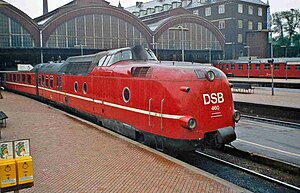DSB MA
| DSB MA | |
|---|---|
| Numbering: | MA 460-470; BS 480-489 |
| Number: | 10 + one powered end car |
| Manufacturer: | MAN AG (Maschinenfabrik Augsburg-Nürnberg AG) |
| Year of construction (s): | 1963-1966 |
| Retirement: | 1990 |
| Gauge : | 1435 mm ( standard gauge ) |
| Length over buffers: | 75,280 mm |
| Top speed: | 140-160 km / h |
| Continuous output : | 801 kW |
The MA series were diesel-hydraulic express multiple units of the Danish State Railways (DSB). The trains were also referred to as Lyntog .
history
From 1963 the four-part multiple units replaced the pre-war models in Lyntog traffic (lightning train). The trains are derived from the German TEE multiple units of the VT 11.5 (601) series of the Deutsche Bundesbahn and were manufactured by MAN AG (Maschinenfabrik Augsburg-Nürnberg AG). For the Danish order for ten trains with eleven motor cars (MA 460 to 470), a motorless end car was redesigned as a control car (BS 480 to 489): It was given a high driver's cab and a rubber bead transition so that two multiple units can be automatically coupled together using a Scharfenberg coupler could, but were nonetheless continuously accessible. The shortening to four cars was necessary in view of the length of the railway ferries across the Great Belt . At the same time, this created the possibility of driving at "half" capacity on less frequented routes. The (full) trains consisting of two railcars had the following train sequence: Ma - Am - Bm - Bs + Bs - Bmk - Am - Ma (Am = 1st class; Bm = 2nd class; Bmk = 2nd class with kitchen / Restaurant, later kiosk; Bs = driving car with 2nd class). While the 1st class cars were equipped with compartments , the 2nd class was designed as an open plan. There were also luggage compartments in the motor vehicles.
The sources for the maximum speed of the trains fluctuates between 140 km / h and 160 km / h, the engines produce 1,100 hp. The wheel arrangement for the motor vehicle is B '2', i.e. two driven axles in one bogie (under the nose) and two motorless axles in the rear bogie. The intermediate cars each have two two-axle bogies. The main area of application was the high-quality traffic between Copenhagen and Jutland .
Originally painted in a light wine-red color, they were modernized from 1984 onwards and painted silver on the outside, giving them nicknames such as Sølvpilen (Silver Arrow) or Staniolexpressen .
After the first delivery of the successor MF in 1990, this series was taken out of service.
Use in Poland
In 1992 nine train sets were delivered to Poland . From May 23, 1993, five operable trains were in service with the private railway "Lubuska Kolej Regionalna" (Lubuska Kolej Regionalna, LKR) until it went bankrupt in 1994. Due to concession problems, the trains were only allowed to be used on their own LKR routes. The more lucrative use on the PKP network was denied. In the following period, all vehicles are said to have been scrapped.
Whereabouts
In Denmark preserved and operational are:
Railcar MA 460 - Intermediate car AM 500 (1st class side aisle) - Intermediate car BMK 530 (2nd class open plan and buffet compartment) - Control car BS 480 (2nd class open plan)
literature
- Rüdiger Block: The VT 11.5 series . Eisenbahn Kurier Verlag, Freiburg 1988, ISBN 3-88255-200-X , pp. 224–241
Web links
- Lyntog (Danish)
- Deployment in Poland (German)
- Technical data and whereabouts of the MA (Danish)
Individual evidence
- ↑ WITH DANISH EXPRESS TRAINS RUMPING THROUGH POLISH GRASS ... In: interlok.info Retrieved May 27, 2019 .
- ↑ DSB lyntog og togsæt. In: jernbanen.dk. Retrieved April 24, 2020 (Danish).


